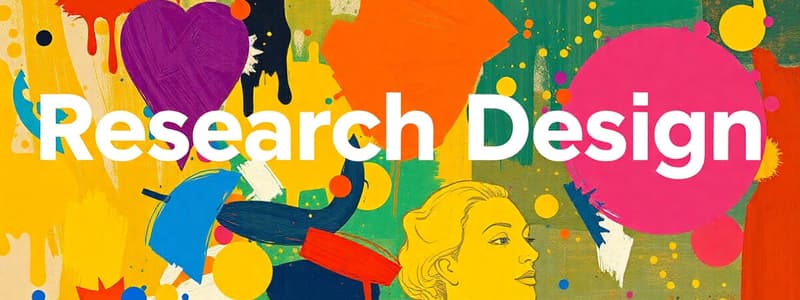Podcast
Questions and Answers
Which of the following is NOT a characteristic of exploratory research?
Which of the following is NOT a characteristic of exploratory research?
- Production of tentative findings
- Understanding and generating ideas
- Qualitative and quantitative data
- Inflexible Process (correct)
What type of research is used to test hypotheses and relationships?
What type of research is used to test hypotheses and relationships?
- Descriptive and Casual (correct)
- Exploratory
- Qualitative
- Conclusive
What is the primary risk of defining a research scope too narrowly during problem formulation?
What is the primary risk of defining a research scope too narrowly during problem formulation?
- Ignoring vital elements of decision problems. (correct)
- Increased costs and time consumption.
- Difficulty developing a manageable research approach.
- Inability to produce tentative findings.
In the research process, what immediately follows data collection?
In the research process, what immediately follows data collection?
Which of these data types is collected for a different purpose than the current research question?
Which of these data types is collected for a different purpose than the current research question?
What is the main function of eye-tracking technology in consumer research?
What is the main function of eye-tracking technology in consumer research?
Which research method involves researchers immersing themselves in a specific culture?
Which research method involves researchers immersing themselves in a specific culture?
What potential bias is introduced when individuals alter their behavior because they know they are being observed?
What potential bias is introduced when individuals alter their behavior because they know they are being observed?
What is a key advantage of using focus groups in research?
What is a key advantage of using focus groups in research?
Critically evaluate which aspect of interviews is MOST crucial for ensuring the quality and applicability of the data collected?
Critically evaluate which aspect of interviews is MOST crucial for ensuring the quality and applicability of the data collected?
Flashcards
Exploratory Research
Exploratory Research
Used to understand and generate initial ideas with a flexible process, often producing tentative findings.
Descriptive and Casual Research
Descriptive and Casual Research
Used to test specific hypotheses and relationships with clear definitions and quantitative analysis, aiming to produce conclusive findings.
Primary Data
Primary Data
Data collected firsthand to address specific research questions, offering accuracy but at a higher cost and time investment.
Secondary Data
Secondary Data
Signup and view all the flashcards
Eye Tracking
Eye Tracking
Signup and view all the flashcards
Ethnography
Ethnography
Signup and view all the flashcards
Hawthorne Effect
Hawthorne Effect
Signup and view all the flashcards
Focus Groups
Focus Groups
Signup and view all the flashcards
Interviews
Interviews
Signup and view all the flashcards
Study Notes
Research Design: Exploratory
- Aims to understand and generate ideas
- Uses a flexible process
- Can be both qualitative and quantitative
- Findings are tentative
Research Design: Descriptive and Casual
- Designed to test hypotheses and relationships
- Clear definitions of input and output
- Uses quantitative analysis of large samples
- Produces conclusive findings
What is a Problem?
- Finding the optimal scope includes considerations about the scope of investigation
- A definition that is too wide makes it difficult to develop a manageable research approach
- A scope that is too narrow may exclude important components of decisions problems
Case Study Example: Kids and Fruit
- The goals are to determine motivators for kids to eat fruit and understanding what children are eating for lunch
Research Process
- Problem formulation comes first
- Data collection (measurement) is next
- Sample design (sampling methods) follows
- Data analysis and interpretation occurs after
- Final report is produced
- Decisions on course of action comes last
Primary Data
- Primary data is collected first hand
- It is specific and accurate
- It is expensive and time consuming
Primary Data Collection Examples
- Observation
- Ethnography
- Focus groups
- Interviews
- Surveys
- Experiments
Secondary Data
- Secondary data is collected for a different purpose than used
- It is fast and cheap
- It is not exactly correlated with problem at hand
Observation: Eye Tracking
- An optical device measures eye movements via reflection of photons from the eye
- It can be used on websites and supermarkets
- Used to determine frequently bought items and amount you shop
- Used determine store brands placed at eye level
- Used for placement of sweet, chocolates and kids toys at lower level for children
Ethnography
- Researchers immerse themselves in specific culture
- The goal is to observed direct behaviour and experience daily behaviour of the interested group
- Hawthorne effect: altering behavior when being watched
Focus Groups
- Acquire impressions, interpretations, and opinions whilst talking about a certain event, concept, brand, product or service
- Focus groups involve discussion with small group of individuals (chosen due to their expertise)
- Produces rich and versatile data
Interviews
- Interviews involve obtaining info on issues of interests, face-to-face
- Interviews can be structured or unstructured
- Important aspects of the process include: expertise of interviewer, motivation of interviewee, duration and generalizability
Studying That Suits You
Use AI to generate personalized quizzes and flashcards to suit your learning preferences.




